carsinamerica
ACCESS: Confidential
- Joined
- 18 February 2010
- Messages
- 118
- Reaction score
- 61
This is a bizarre question, and I do hope that I've put in the right place. I've been researching the 737-300/400/500 in order to produce some very picky scale drawings, and I've found a discrepancy. According to almost every source, the 737-400 is exactly 10 ft (120 inches) longer than the 737-300. Boeing's ACAPS documents all insist on this, and secondary sources back them up.
However, I think the 737-400 is actually 20 inches shorter than these figures, and thus exactly 100 inches longer in its fuselage than the 737-300. I'm hoping that someone can either confirm that their has been a drastic typo at Boeing, or prove to me that I'm in error.
Evidence:
1. Windows. Through the simplest (albeit less precise) method, counting windows, we get the following:
* On the -300, there is space for 17 windows between the L1 door and the emergency overwing exit (there's slightly more room on the right side of the plane, because the R1 door is smaller and further forward). On the -400, there is room for 18 windows between the L1 door and FIRST emergency overwing exit, but the -400 has two exits. The extra exit is closer to the front of the plane. The space occupied by the second emergency exit, and the cleared space around it, occupy what would have been two windows. Thus, we have a stretch of three frames, which is approximately 60 inches (window spacing being 19-22 inches on the 737 family.
* On the -300, there is space for 20 windows between the emergency exit and the L2 door. On the -400, this distance is 22 windows. This is two frames, approximately 40 inches.
* On both -300 and -400 models, the L1 door is the same distance from the nose (this distance is the same for all variants of the 737). On both the -300 and -400, the rear seam of the L2 door is almost directly beneath the kink in the vertical stabilizer. Thus, the doors are the same distance from the extreme ends of the fuselage in both planes.
2. Counting fuselage frames. The more precise way to measure a plane's size is to look at a fuselage station diagram. As it happens, a complete copy of the 737-500 station diagram is available on the internet. It's appended to this post. It indicates which frames are common to the -300/-400/-500, and which are unique to each airframe. By adding station numbers, and then adding lettered frames, one can compute the exact length of the airframe.
* On the -500, the nose radome begins at STA 130, and its APU exhaust ends at STA 1217. We must subtract the distance between STA 482 and STA 500, because frame 500 is missing on the -500. We then must add the distance between frames 482 and 482B (44 inches), and frames 747 and 747C (60 inches). We come up with 1173 inches (97 ft 9 in), which is the length of the -500 fuselage according to all known sources.
* According to this diagram, the -300 lacks frames 482A and 482B (44 inches), but adds frames 500 (18 inches), 500A, 500B, 500C, and 500D, plus 727D and 727E. If we assume that each of these added frames is 20 inches (since 727A and 727B are known to be 20-inch frames), then we come up with a length of 1267 inches (105 ft 7 in), which is the accepted length of the 737-300.
* Now, to find the length of the -400, we have to add frames 500E, 500F, and 500G, plus 727F and 727G. If each of these frames is 20 inches -- again, this is an assumption, but one that was accurate for the -300 -- then we've added 5 frames and 100 inches. This matches what is shown by counting windows. Furthermore, this frame count is borne out by Boeing maintenance, parts, and inspection manuals for the -300, -400, and -500, which include partially-labelled frame diagrams.
The only way I see that I could be in error here is if the 5 added frames of the -400 had a much higher pitch than the -300, for example 4 of them being 25 inches, and the fifth 20 inches. However, there's no evidence of that looking at the plane; a 25% increase in frame pitch over part of the fuselage would probably be conspicuous.
However, I think the 737-400 is actually 20 inches shorter than these figures, and thus exactly 100 inches longer in its fuselage than the 737-300. I'm hoping that someone can either confirm that their has been a drastic typo at Boeing, or prove to me that I'm in error.
Evidence:
1. Windows. Through the simplest (albeit less precise) method, counting windows, we get the following:
* On the -300, there is space for 17 windows between the L1 door and the emergency overwing exit (there's slightly more room on the right side of the plane, because the R1 door is smaller and further forward). On the -400, there is room for 18 windows between the L1 door and FIRST emergency overwing exit, but the -400 has two exits. The extra exit is closer to the front of the plane. The space occupied by the second emergency exit, and the cleared space around it, occupy what would have been two windows. Thus, we have a stretch of three frames, which is approximately 60 inches (window spacing being 19-22 inches on the 737 family.
* On the -300, there is space for 20 windows between the emergency exit and the L2 door. On the -400, this distance is 22 windows. This is two frames, approximately 40 inches.
* On both -300 and -400 models, the L1 door is the same distance from the nose (this distance is the same for all variants of the 737). On both the -300 and -400, the rear seam of the L2 door is almost directly beneath the kink in the vertical stabilizer. Thus, the doors are the same distance from the extreme ends of the fuselage in both planes.
2. Counting fuselage frames. The more precise way to measure a plane's size is to look at a fuselage station diagram. As it happens, a complete copy of the 737-500 station diagram is available on the internet. It's appended to this post. It indicates which frames are common to the -300/-400/-500, and which are unique to each airframe. By adding station numbers, and then adding lettered frames, one can compute the exact length of the airframe.
* On the -500, the nose radome begins at STA 130, and its APU exhaust ends at STA 1217. We must subtract the distance between STA 482 and STA 500, because frame 500 is missing on the -500. We then must add the distance between frames 482 and 482B (44 inches), and frames 747 and 747C (60 inches). We come up with 1173 inches (97 ft 9 in), which is the length of the -500 fuselage according to all known sources.
* According to this diagram, the -300 lacks frames 482A and 482B (44 inches), but adds frames 500 (18 inches), 500A, 500B, 500C, and 500D, plus 727D and 727E. If we assume that each of these added frames is 20 inches (since 727A and 727B are known to be 20-inch frames), then we come up with a length of 1267 inches (105 ft 7 in), which is the accepted length of the 737-300.
* Now, to find the length of the -400, we have to add frames 500E, 500F, and 500G, plus 727F and 727G. If each of these frames is 20 inches -- again, this is an assumption, but one that was accurate for the -300 -- then we've added 5 frames and 100 inches. This matches what is shown by counting windows. Furthermore, this frame count is borne out by Boeing maintenance, parts, and inspection manuals for the -300, -400, and -500, which include partially-labelled frame diagrams.
The only way I see that I could be in error here is if the 5 added frames of the -400 had a much higher pitch than the -300, for example 4 of them being 25 inches, and the fifth 20 inches. However, there's no evidence of that looking at the plane; a 25% increase in frame pitch over part of the fuselage would probably be conspicuous.
Attachments
-
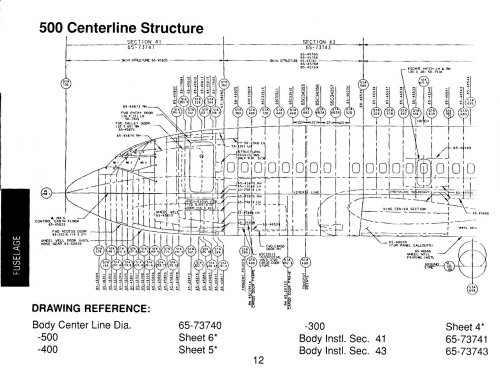 Boeing 737-500 forward fuselage station diagram.jpg247.8 KB · Views: 243
Boeing 737-500 forward fuselage station diagram.jpg247.8 KB · Views: 243 -
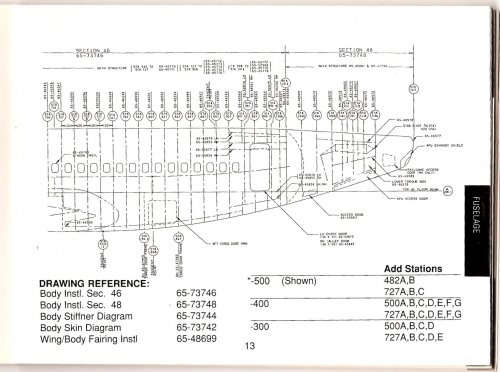 Boeing 737-500 fuselage station diagram tail.jpg232.5 KB · Views: 227
Boeing 737-500 fuselage station diagram tail.jpg232.5 KB · Views: 227 -
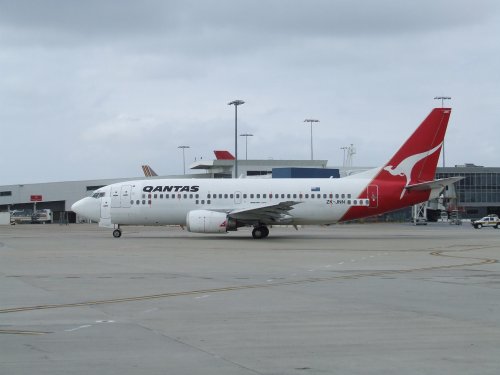 737-300_window_count.JPG289.1 KB · Views: 200
737-300_window_count.JPG289.1 KB · Views: 200 -
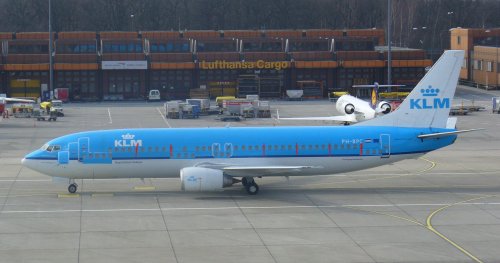 737-400_window_count.JPG314.2 KB · Views: 187
737-400_window_count.JPG314.2 KB · Views: 187 -
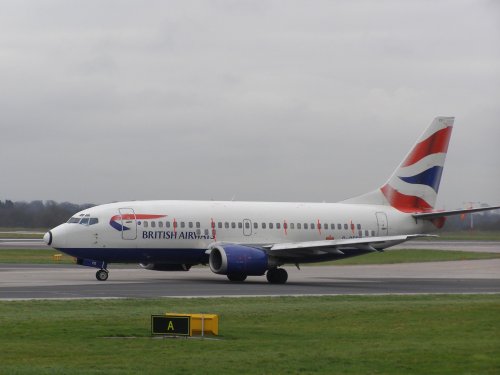 737-500_window_count.JPG389 KB · Views: 182
737-500_window_count.JPG389 KB · Views: 182 -
 737 framing.GIF19.1 KB · Views: 42
737 framing.GIF19.1 KB · Views: 42 -
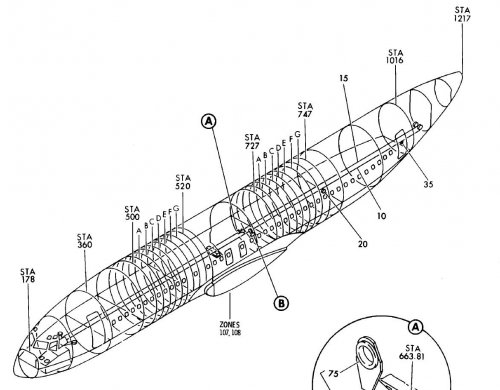 Boeing 737-400 framing.JPG118.6 KB · Views: 46
Boeing 737-400 framing.JPG118.6 KB · Views: 46
